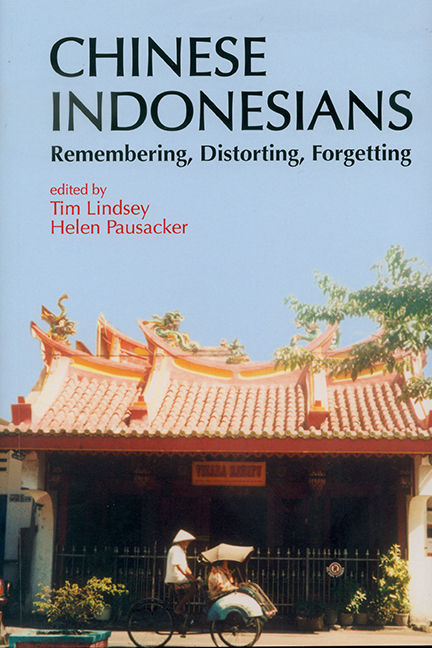Book contents
- Frontmatter
- Contents
- Preface
- A Brief Biography
- Contributors
- Glossary
- Introduction: Researching the Margins
- Bibliography of Charles Coppel's Work
- 1 Anti-Chinese Violence and Transitions in Indonesia: June 1998–October 1999
- 2 Reconstituting the Ethnic Chinese in Post-Soeharto Indonesia: Law, Racial Discrimination, and Reform
- 3 Buddhism and Confucianism in Contemporary Indonesia: Recent Developments
- 4 Portrait of the Chinese in Post-Soeharto Indonesia
- 5 The Makam Juang Mandor Monument: Remembering and Distorting the History of the Chinese of West Kalimantan
- 6 Confucianists and Revolutionaries in Surabaya (c1880–c1906)
- 7 The Chinese and the Early Centuries of Conversion to Islam in Indonesia
- 8 The Agony of Love: A Study of Peranakan Chinese Courtship and Marriage
- 9 Peranakan Chinese and Wayang in Java
- Index
9 - Peranakan Chinese and Wayang in Java
Published online by Cambridge University Press: 21 October 2015
- Frontmatter
- Contents
- Preface
- A Brief Biography
- Contributors
- Glossary
- Introduction: Researching the Margins
- Bibliography of Charles Coppel's Work
- 1 Anti-Chinese Violence and Transitions in Indonesia: June 1998–October 1999
- 2 Reconstituting the Ethnic Chinese in Post-Soeharto Indonesia: Law, Racial Discrimination, and Reform
- 3 Buddhism and Confucianism in Contemporary Indonesia: Recent Developments
- 4 Portrait of the Chinese in Post-Soeharto Indonesia
- 5 The Makam Juang Mandor Monument: Remembering and Distorting the History of the Chinese of West Kalimantan
- 6 Confucianists and Revolutionaries in Surabaya (c1880–c1906)
- 7 The Chinese and the Early Centuries of Conversion to Islam in Indonesia
- 8 The Agony of Love: A Study of Peranakan Chinese Courtship and Marriage
- 9 Peranakan Chinese and Wayang in Java
- Index
Summary
INTRODUCTION
The Chinese in Indonesia have frequently been characterized with the racial stereotype of being “exclusive”, mixing mainly within their own community, and being solely business-oriented. Some indigenous Indonesians perceive the Chinese as busy working in trade and industry and having little time for normal social relations. Differences in religion and culture with their surrounding community are also seen to add to the “cultural differences” between them and the surrounding community (Noegroho and Irawan, 1998, p. 8). Nowadays, the Chinese in Java — even the peranakan Chinese, born in Indonesia and speaking Indonesian and often the regional language as their first languages are not seen as patrons of, and participants in, the formation of culture generally, much less wayang purwa, seen by many as the pinnacle of Javanese culture.
Charles Coppel has argued that scholars in the 1930s and 1940s, such as J.S. Furnivall in his book Netherlands Indies (1939), who argued that the Dutch Indies consisted of “separate communities” who met in the marketplace, may well have contributed to such stereotypes and given rise to the idea of there being a “Chinese problem” in Indonesia (Coppel 2002a, pp. 136, 150). Furnivall argued that in the Netherlands Indies, “[e]ach group holds by its own religion, its own culture and its own ideas and ways of life: the members of each group mix with those of other groups only in the market place, in buying and selling” (Furnivall 1945, pp. 167–68, as quoted in Coppel 2002a, p. 137). Charles Coppel, however, describes a society at the turn of the twentieth century that could be better termed a “mestizo society”, with a joint social life and culture, both low Malay literature and theatre — particularly the komedi stambul, a theatre form in late colonial times, known for its racial mix.
- Type
- Chapter
- Information
- Chinese IndonesiansRemembering, Distorting, Forgetting, pp. 185 - 208Publisher: ISEAS–Yusof Ishak InstitutePrint publication year: 2005

